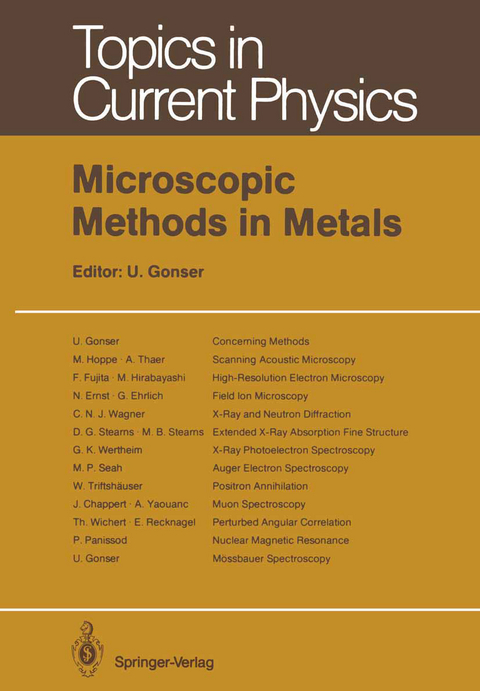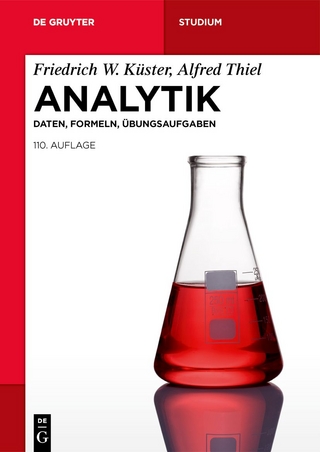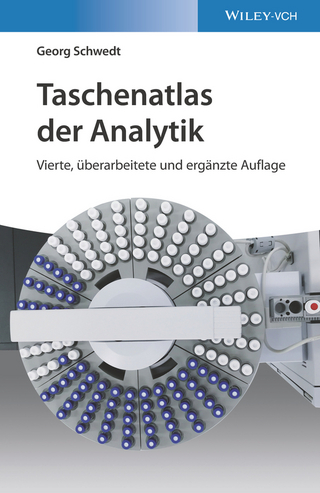
Microscopic Methods in Metals
Springer Berlin (Verlag)
978-3-642-46573-4 (ISBN)
1. Concerning Methods.- 1.1 Descriptive Methods.- 1.2 Abbreviated Methods.- 1.3 Name-Tag Methods.- 2. Scanning Acoustic Microscopy.- 2.1 Principle of Scanning Acoustic Microscopy (SAM).- 2.2 The Image Contrast of Solids in the Reflection Scanning Acoustic Microscope; V(z)-Curves.- 2.3 Examples of Practical Applications of Reflection Scanning Acoustic Microscopy.- 2.4 Outlook.- References27.- 3. High-Resolution Electron Microscopy.- 3.1 Background.- 3.2 Basic Principles of High-Resolution Electron Microscopy.- 3.3 Applications.- 3.4 Outlook.- References.- 4. Field Ion Microscopy.- 4.1 Principles and Techniques.- 4.2 Illustrative FIM Studies.- References.- 5. X-Ray and Neutron Diffraction.- 5.1 Diffraction of Neutrons and X-Rays by Poly- and Non-Crystalline Alloys.- 5.2 Experimental Techniques.- 5.3 Applications.- References.- 6. Extended X-Ray Absorption Fine Structure.- 6.1 Theory.- 6.2 Experimental Techniques.- 6.3 Analysis.- 6.4 Experimental Applications.- References.- 7. X-Ray Photoelectron Spectroscopy.- 7.1 Historical.- 7.2 Basic Principles.- 7.3 Related Methods.- 7.4 Applications.- 7.5 Recent Developments.- References.- 8. Auger Electron Spectroscopy.- 8.1 History.- 8.2 Principles.- 8.3 The Instrument.- 8.4 Related Methods.- 8.5 Applications.- 8.6 Future Developments.- References.- 9. Positron Annihilation.- 9.1 Background.- 9.2 Basic Principles.- 9.4 Applications.- 9.5 Conclusions and Outlook.- References.- 10. Muon Spectroscopy.- 10.1 Basic Principles of the Experimental Techniques.- 10.2 The Depolarization Functions.- 10.3 Diffusion Studies by ?+ SR.- 10.4 Magnetic Studies by ?+ SR.- 10.5 Conclusions.- References.- 11. Perturbed Angular Correlation.- 11.1 Background.- 11.2 Principles.- 11.3 Detection of Hyperfine Fields.- 11.4 Radioactive Probes, Preparationand Techniques.- 11.5 Applications.- 11.6 Future Developments and Conclusions.- References.- 12. Nuclear Magnetic Resonance.- 12.1 Introductory Comments.- 12.2 Physical Background of an NMR Experiment - Hyperfine Interactions.- 12.3 Basic NMR Experiment - Principles and Setup.- 12.4 NMR Outputs - Microscopic Origin.- 12.5 Applications - Structural Investigations.- 12.7 Conclusion and Outlook.- References.- 13. Mössbauer Spectroscopy.- 13.1 History.- 13.2 Principles.- 13.3 Mössbauer Isotopes.- 13.4 Methodology.- 13.5 Hyperfine Interactions.- 13.5.1 Isomer Shift.- 13.6 Relativistic Effects.- 13.7 Time-Dependent Effects.- 13.8 Applications.- 13.9 Outlook.- References.- Additional References with Titles.
| Erscheint lt. Verlag | 25.2.2012 |
|---|---|
| Reihe/Serie | Topics in Current Physics |
| Zusatzinfo | XVI, 457 p. |
| Verlagsort | Berlin |
| Sprache | englisch |
| Maße | 170 x 244 mm |
| Gewicht | 813 g |
| Themenwelt | Naturwissenschaften ► Chemie ► Analytische Chemie |
| Naturwissenschaften ► Physik / Astronomie ► Atom- / Kern- / Molekularphysik | |
| Naturwissenschaften ► Physik / Astronomie ► Festkörperphysik | |
| Naturwissenschaften ► Physik / Astronomie ► Optik | |
| Schlagworte | Crystal • Diffusion • electron microscopy • electron spectroscopy • Intermetallic compound • magnetism • Microscopy • Mössbauer spectroscopy • Nuclear Magnetic Resonance (NMR) • phase transition • photoelectron spectroscopy • scattering • Segregation • spectroscopy • X-ray Emission Spectroscopy |
| ISBN-10 | 3-642-46573-0 / 3642465730 |
| ISBN-13 | 978-3-642-46573-4 / 9783642465734 |
| Zustand | Neuware |
| Informationen gemäß Produktsicherheitsverordnung (GPSR) | |
| Haben Sie eine Frage zum Produkt? |
aus dem Bereich


